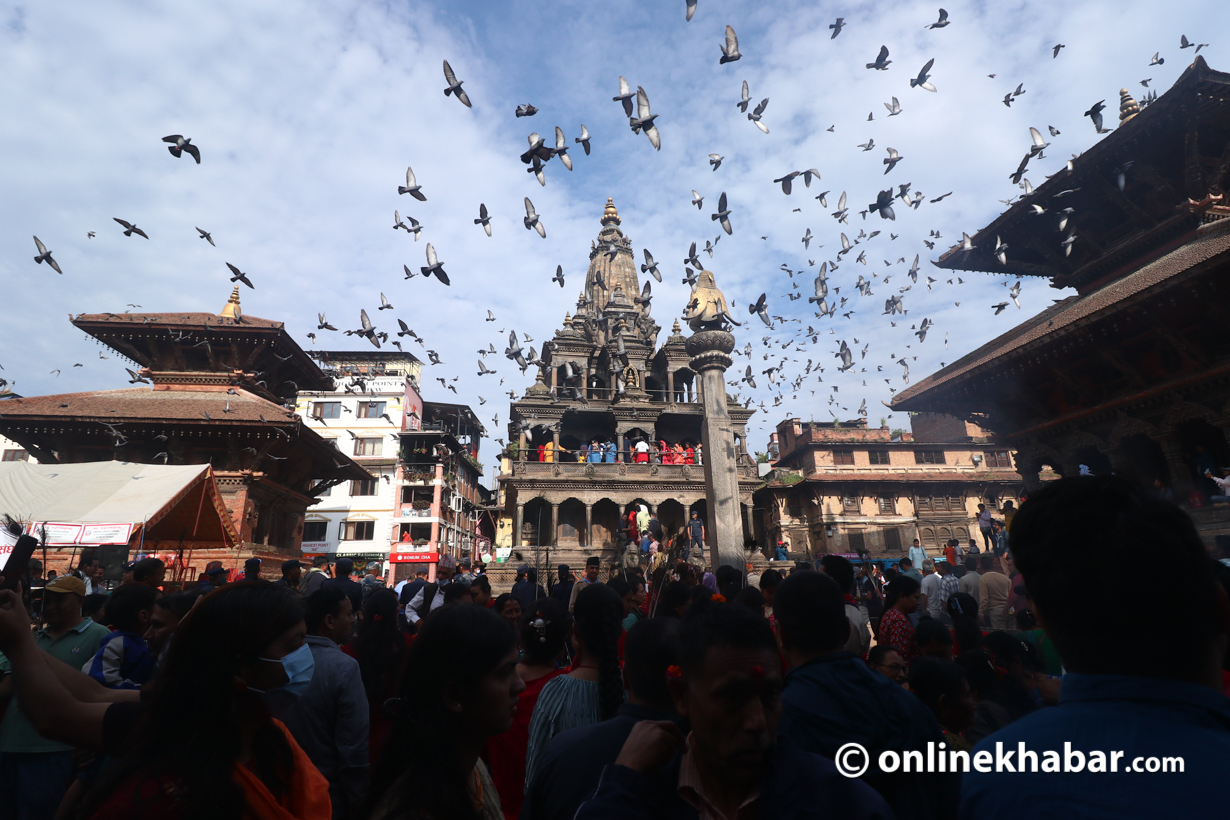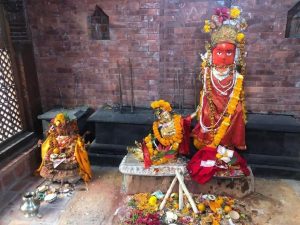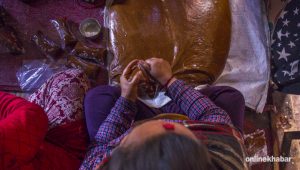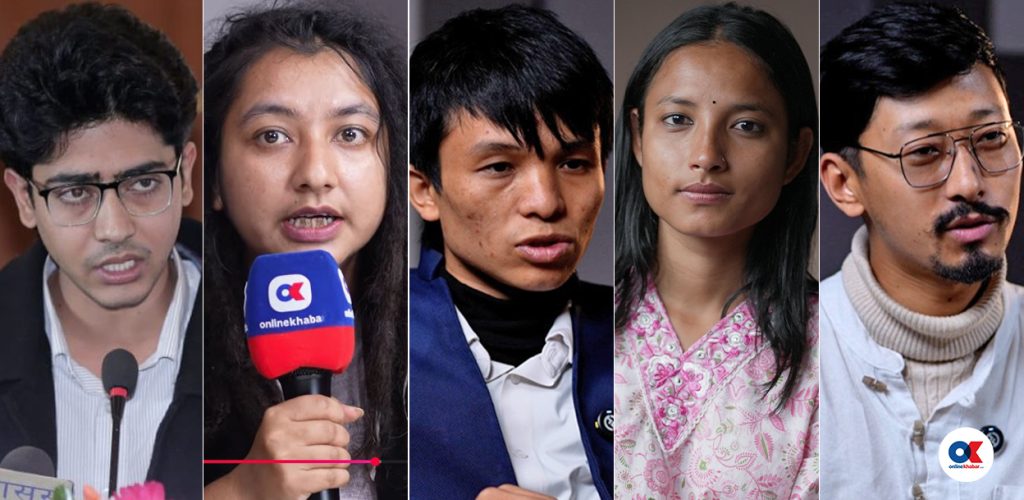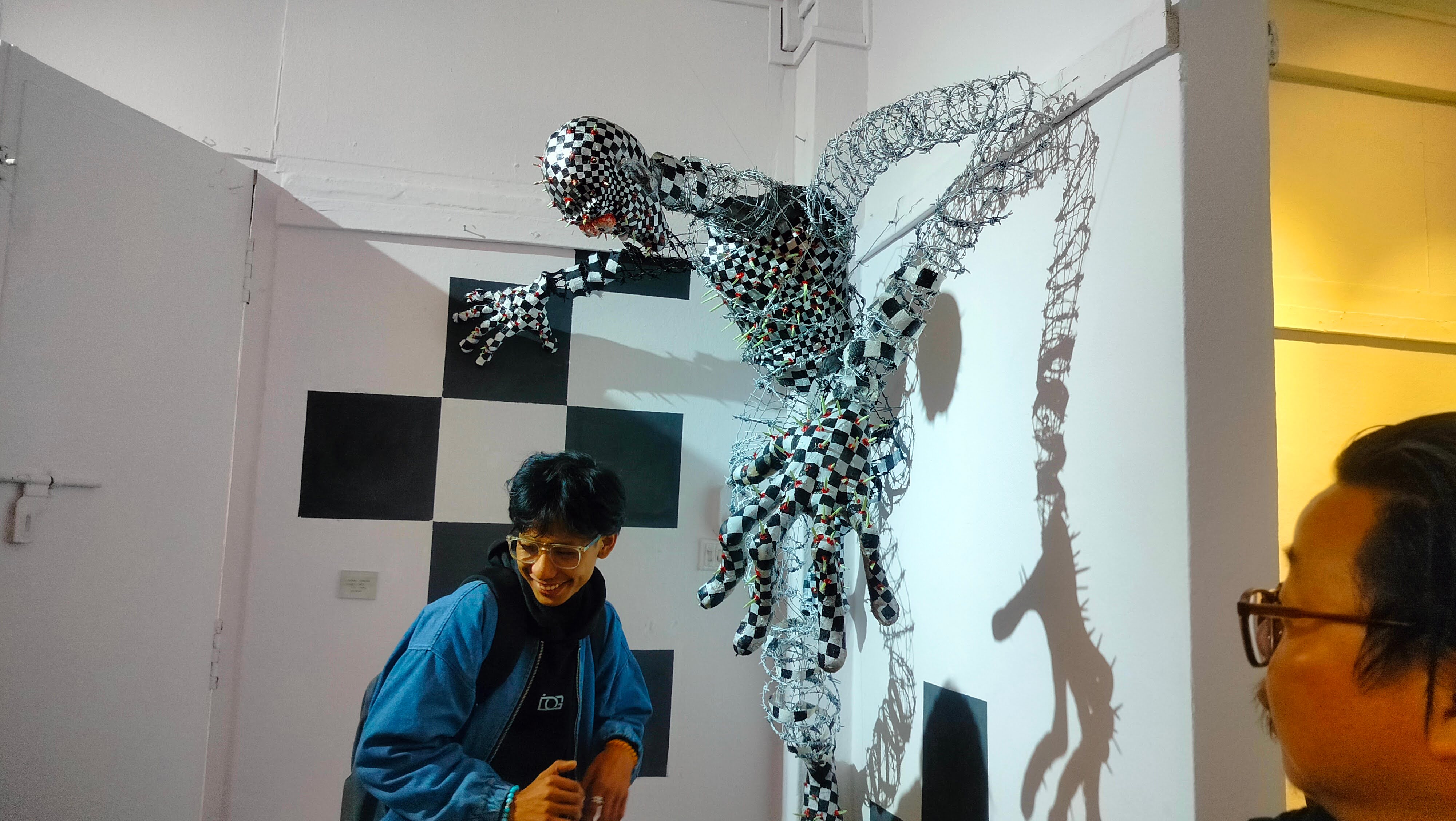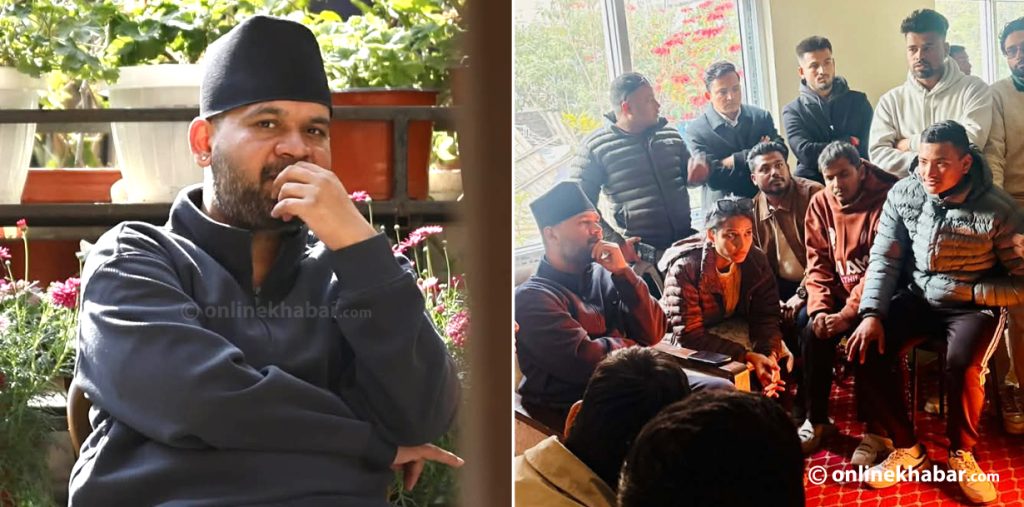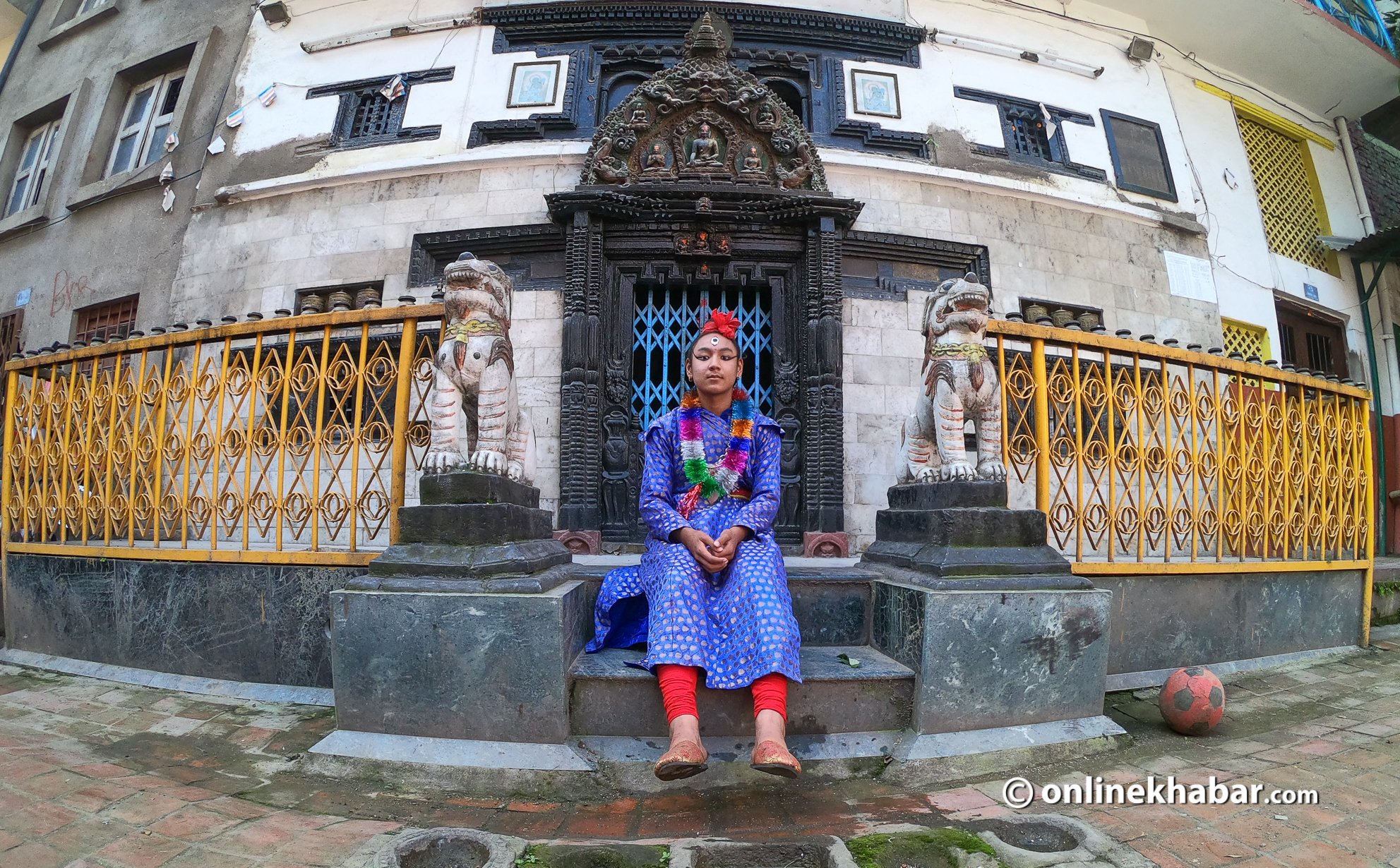
Amid the teenage students in uniform, Rojan Shakya stands out in his long blue kurta-suruwal, and a shimmering, jagged traditional vest. Where his school imposes a strict rule on short hairs for others, he can be seen with long hairs too, tied in a tight bun with red ribbons. In conventional standards, to see a tall boy with long black kohl in his eyes that stretches all the way to his temples is just strange.
He is registered in the school records as ‘Rojan Shakya’ yet everyone addresses him as Bhagawan (God). But it was not Shakya who declared himself a god. The hundreds of thousands of people in Kathmandu, especially the Newa: community, regard him as a god, a living embodiment of Lord Bhairav. They worship him, give their offerings, ask for blessings and even put him on a chariot alongside the living goddess Kumari and Lord Ganesh.
Despite the title, Shakya still feels like a common ninth-grader like any other studying at Jana Jyoti Secondary School, Kalimati. But, every morning and night, he still fulfils his duty and sits on a throne.
The school also treats him like other students. Apart from his attire, Shakya does not get any special treatment. In fact, he has to follow more rules than any of his classmates.
***
He has to reach the school on time, attend the morning prayers, do his homework and catch up with the lessons taught. He needs to even mug up grammar rules, participate in classroom and extracurricular activities.
But that’s not all, he still has to bind himself with more rules as a god. He cannot go anywhere he likes, or anything he likes; no movies with friends, no fast food, no travelling or hanging out with friends. Shakya is a ‘God in Dilemma’, who blesses his worshippers with the fulfilment of all they wish but cannot do as he wishes.
Because of his attire, he is stared at by people while some even tease him for ‘looking like a girl’. This riles him; he even shouts “I’m not a girl”. “I have only lived a disciplined life. Sometimes it makes me emotional because I can do nothing I like,” he says.
Once he is free of this lifestyle, he wants to do everything he has ever dreamt of; he wants to travel, play football, watch movies with friends, and pursue a degree in computer engineering. “I am restricting myself, convincing myself,” he says, “But, it is only for a year or so, then I can do as I want and I will.”
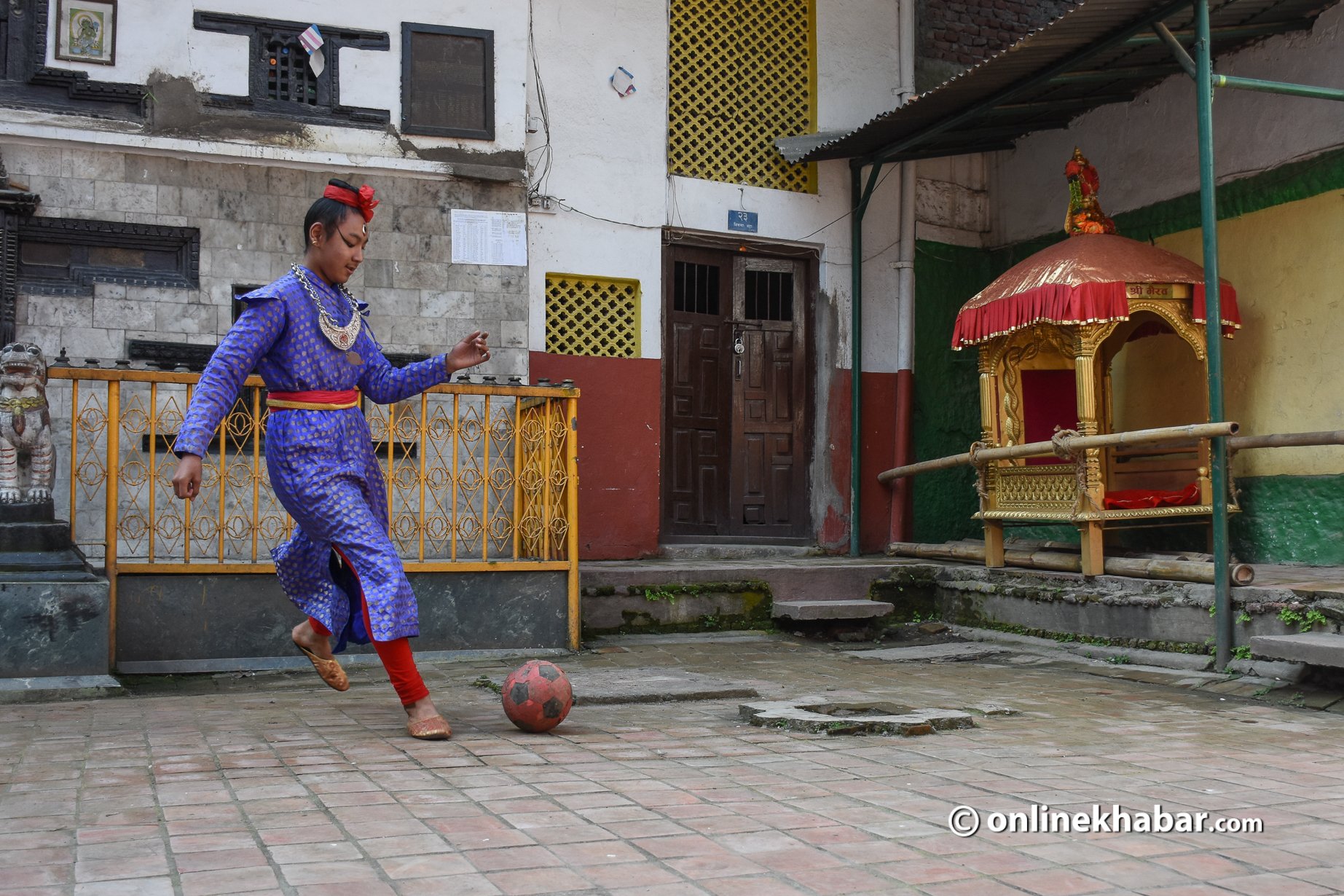
There are many such rules the Bhairav has to follow. What happens if he does not? Well, according to mythology, it invites disaster for the country and for the Bhairav too. And with this belief, the tradition has continued for centuries.
Every Indra Jatra, the Kathmandu Valley is immersed in a joyous vibe and Shakya also enjoys being Bhairav. But he also battles a fear, “There might be an accident of some sort–people who pull the chariot drink, so the fear is imminent. If only they do it without any influence. I am a god, but I fear for my life too.”
***

In his class, Shakya seems immersed in his lessons, using his fingers and calculators to do the maths, copying the notes from whiteboards. When anyone submits assignments before him, it upsets him a bit. However, neither his pen stops nor his determination to learn like a normal teenager.
On Fridays, the school organises extracurricular activities and one of the regular events is a kho-kho match. Shakya is a regular kho-kho player of the school. On the field, he is equally excited and energetic to win like his teammates. He jumps in the excitement of winning and feels sad when his team lose.
 ****
****
Shakya lives in his own home at Ombahal Chok of Kathmandu. The house is small, a typical old Newari house with wooden staircases. Two floors up, there is a ‘throne’ where he sits and becomes Bhairab when he is not in school.
This is both a house and a temple for his family lives on another floor of the same building.
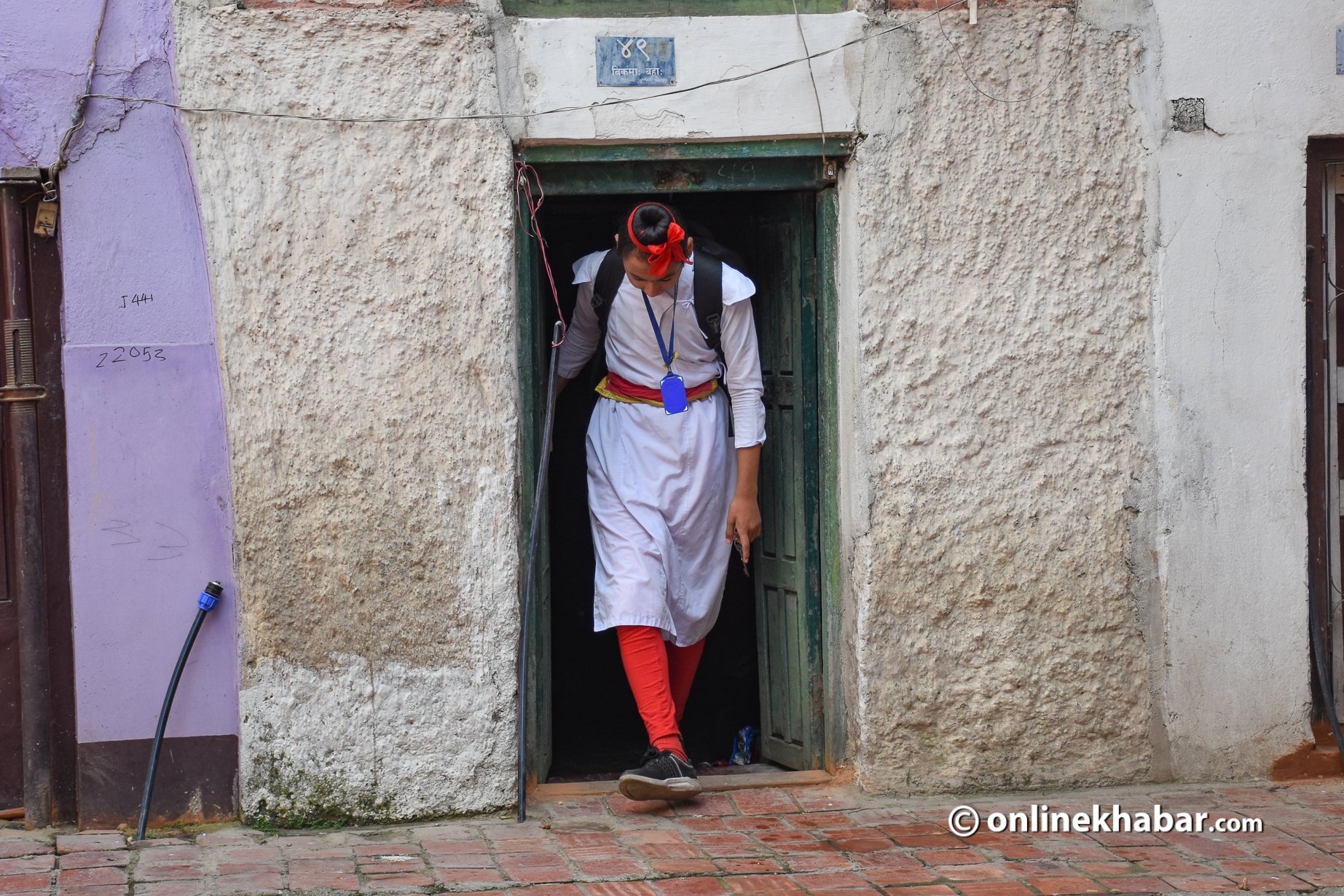 Shakya is a living embodiment of the lord Bhairav; he is as powerful as living goddess Kumari and Lord Ganesh. However, he does not create the same hype among the public. Why? It is a valid question, yet no has concrete answers; it is only restricted to hearsays.
Shakya is a living embodiment of the lord Bhairav; he is as powerful as living goddess Kumari and Lord Ganesh. However, he does not create the same hype among the public. Why? It is a valid question, yet no has concrete answers; it is only restricted to hearsays.
Shakya comes from the Shakya clan, which is the most basic requirement for anyone who wants to become the lord. His uncle (mother’s brother), Bhairav Shakya, also sat on the same throne 32 years ago. Starting from the age of two, his uncle was worshipped as Bhairav for 12 years. Thereafter, he was ‘free’ and now is busy in family life.
The uncle remembers how the late King Birendra Shah came to receive tika from his hands. It was a tradition to worship the living embodiment of Lord Bhairav every time the monarch changed.
Now, the tradition has changed along with the political system. “During Kumari Jatra too, the monarch used to come to the Bhairav’s house to worship but with the change of government, this tradition has also changed. Nothing is being held according to traditions,” Bhairav adds.
The vibe of the festival then was very different too. “We cannot find the people believing in the tradition now,” he observes, “This is the result when the nation takes traditions only as compliance, a liability.”
Rojan’s father, Uttam Shakya, says he has been asked different questions for keeping the tradition alive: What will you get following traditions? What will you get by worshipping humans as gods? He might not have answers to their questions, but he says he knows the traditions are important. And he realises if one stops following traditions, the culture will cease to exist.
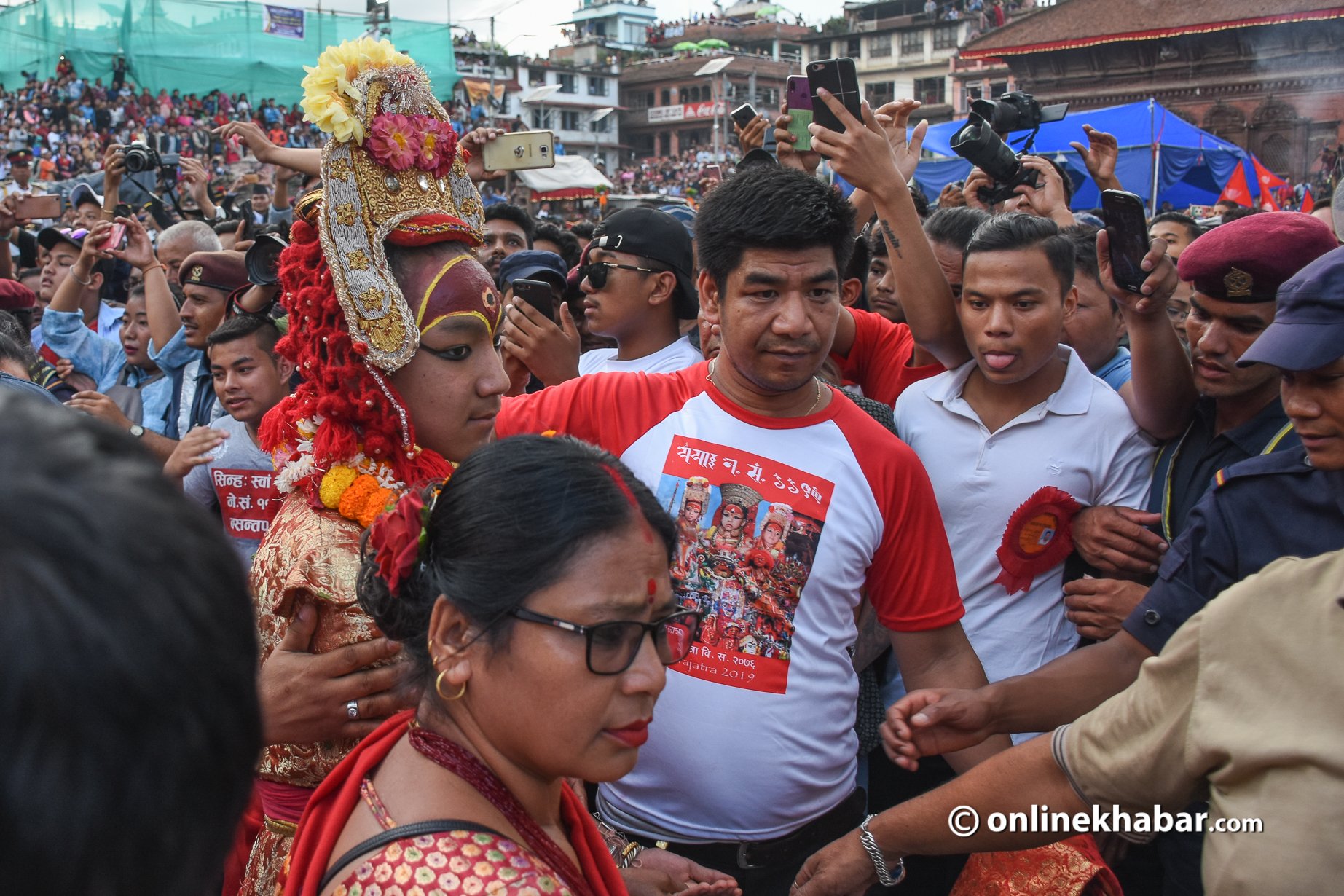 According to cultural beliefs, Bhairav is a protector of the nation. During the Lichhavi period, when King Guna Kamadev set up Kantipur, he also established shrines of Bhairav along with Ashtamatrika on the southern part of the valley (Teku) to protect the kingdom. Mythology says Bhairav and goddess Kumari are considered the two wheels of the Indra Jatra chariot. Bhairav, Kumari, and Ganesh are taken as the divine powers who prevent any mishaps in the country and that’s why they are worshipped as living gods.
According to cultural beliefs, Bhairav is a protector of the nation. During the Lichhavi period, when King Guna Kamadev set up Kantipur, he also established shrines of Bhairav along with Ashtamatrika on the southern part of the valley (Teku) to protect the kingdom. Mythology says Bhairav and goddess Kumari are considered the two wheels of the Indra Jatra chariot. Bhairav, Kumari, and Ganesh are taken as the divine powers who prevent any mishaps in the country and that’s why they are worshipped as living gods.
When some unfortunate happens in the country, the people assume that the gods are unhappy.
***
Not everyone can be the Bhairav, like Shakya, just because they wish to. There are rules and traditions. For this, the boy has to be born in the Shakya family of Kathmandu. Further, both the parents have to be the children of Shakyas in Kathmandu. Then, even among those who qualify, only those who do not have any cuts or bruises on his body qualifies to be the Bhairav.
One who passes all these criteria still has to get approval from the guwaju or gurubaa (priest) of the community. They pick the Bhairav looking at his birth chart, alignment of stars and their traits.
Just like when the Kumari changes after her first menstruation, the Bhairav also retires every 14-15 years. Further, when the Kumari retire, both the Bhairav and the Ganesh follow suit, customarily. But there are some exceptions.
Shakya, who became the Bhairav when he was two-and-a-half years old, is now 15. When the new Kumari was anointed last year, there was a plan to find a new Bhairav too. Many children were considered, but the community is yet to find one who qualifies perfectly. The search is still on.
Of course, the community people found a few, but their families did not agree. The families believe it is better to not take the responsibility to follow the traditions and make their child go through a strict lifestyle, without enough economic support.
Unlike the living goddess Kumari, both the Ganesh and the Bhairav do not enjoy any privilege or support for living. According to Uttam, Shakya’s dad, the Bhairav, however, also has to follow all the rules. Hence, other families consider it burdensome.
The Bhairav has to wear long kurta and suruwal; he cannot wear shirts and pants like others. He cannot cut his hair, or eat from the plates that others use. Neither can he attend parties nor can he cross the rivers. Furthermore, the parents have to throw a big party and invite the whole community, at least three times a year.
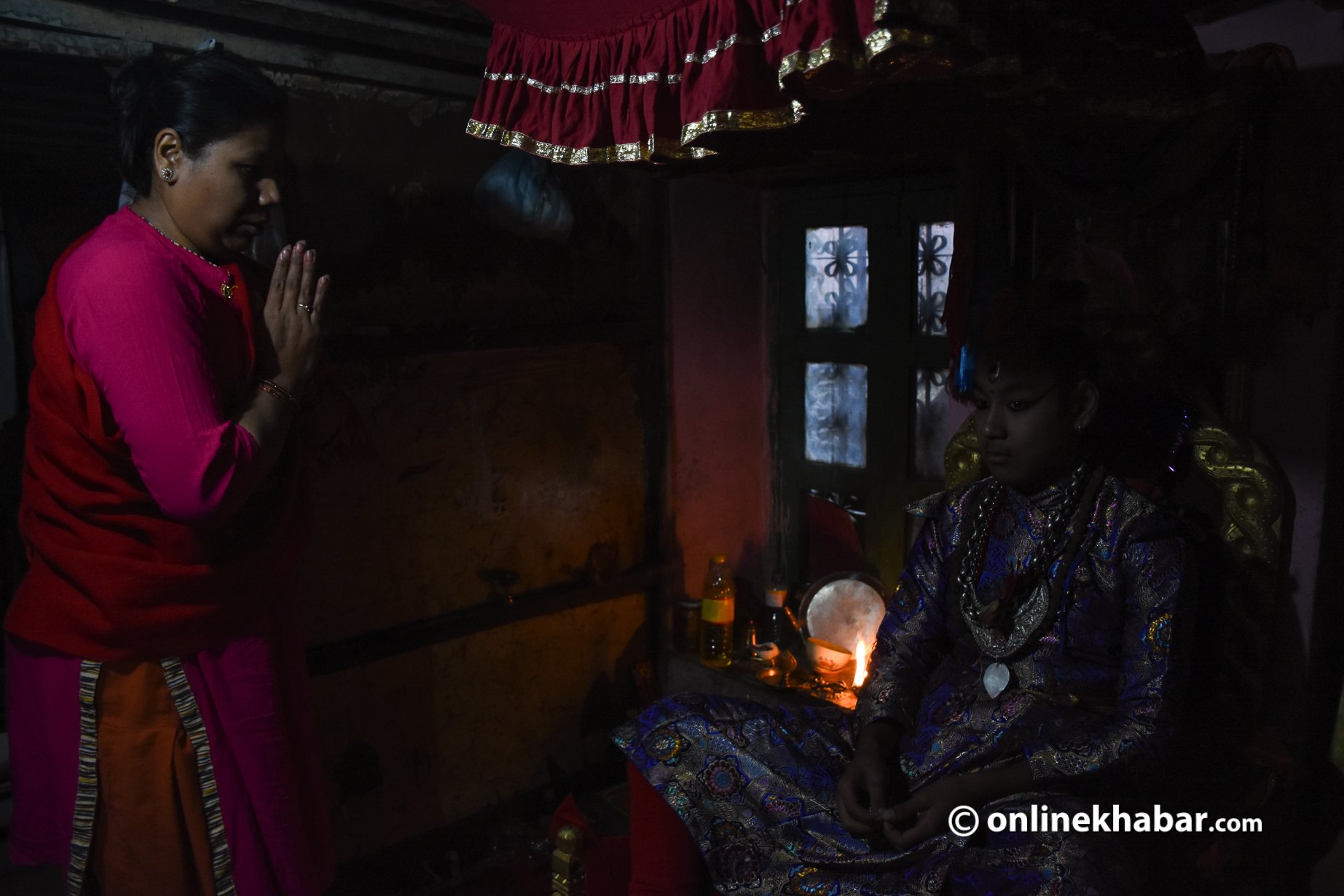 The family has to perform a nitya puja (daily worshipping) and prepare prasad (offerings) to the devotees. A big chunk of money is spent on clothes and pieces of jewellery. They have to give money to the Jyapu Baja: (traditional musical group). On top of that, they have to give seven muri rice grain as tax. Keeping tradition alive is costly.
The family has to perform a nitya puja (daily worshipping) and prepare prasad (offerings) to the devotees. A big chunk of money is spent on clothes and pieces of jewellery. They have to give money to the Jyapu Baja: (traditional musical group). On top of that, they have to give seven muri rice grain as tax. Keeping tradition alive is costly.
Only recently, the Kathmandu metropolitan city has started giving them Rs 30,000 a month as allowance. Uttam says the money is still not enough. His wife Subarna Tara Shakya shares the family also has problems to even pay the child’s school fees. “If we do not follow the tradition, it will cease to exist; but if we do, the financial burden will become even bigger,” she questions, “How can a tradition live long if only one family is to bear their responsibilities?”
It also takes a lot of time for the family to take care of the Bhairav and his needs throughout the day. Uttam is going through a dilemma on whether to abandon the tradition owing to the economic burden or suffer the burden and continue the traditional values. Fighting the dilemma, he every time chooses to continue in favour of religious and traditional values. “It is not right to think like everybody else either, my family and the nation might suffer.”
It has been years that the Uttam and his family have been asking for separate living facilities for the Ganesh and Bhairav like there is one for the Kumari. But, their appeal has gone unheard. “If they have a separate facility, tourists and devotees can come to visit them, and it can ease the burden.”
Photos: Chandra Bahadur Ale








